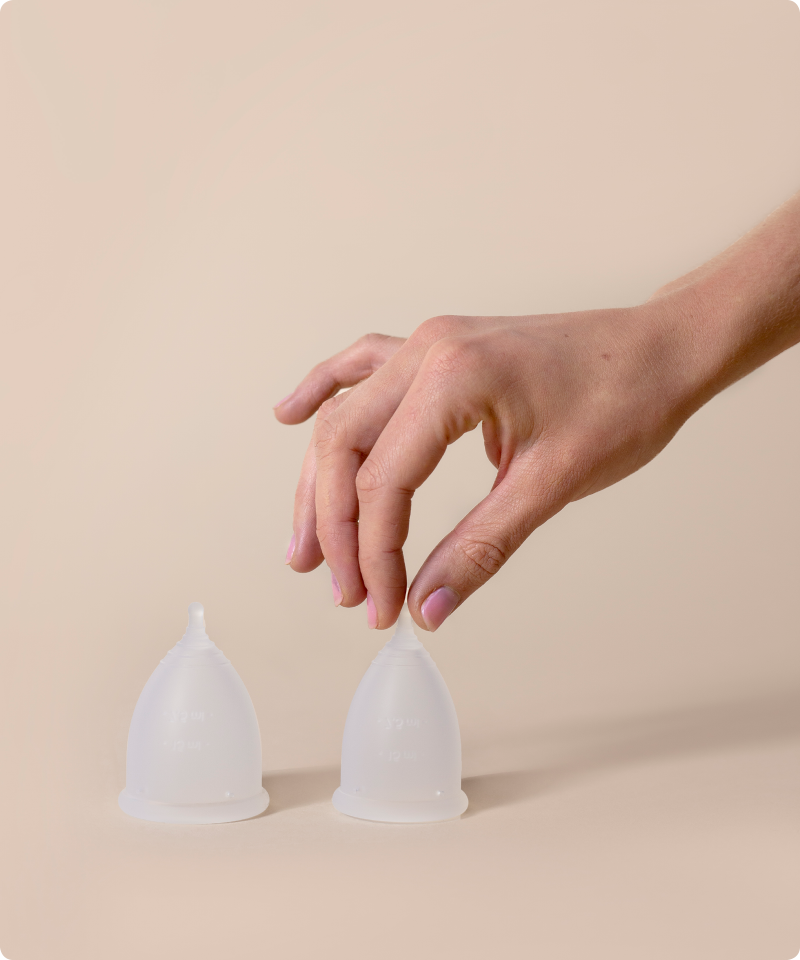Involuntarily losing urine or not being able to hold your urine properly. How does that happen?
Urinary incontinence doesn’t only happen in older or pregnant people. One in five women suffer from it, and incontinence also isn’t rare in men and other individuals with a penis. Talking about this ‘embarrassing’ topic tends to be quite hard for us, which is why we often don’t ask for help. Even though that isn’t necessary at all! In many cases, there’s something you can do about it.
Stress incontinence and urge incontinence: what’s the difference?
Urinary incontinence really just means unwanted urine loss. Losing pee at moments when you don’t want it. You can divide urinary incontinence into two categories: stress urinary incontinence (or exertional incontinence) and so-called urge urinary incontinence.
Stress urinary incontinence
By stress urinary incontinence, or exertional incontinence, we mean involuntary loss of urine, for example when sneezing, coughing, jumping on a trampoline, or when getting up from a chair. Urine loss can also occur during a long walk or run.
What is the cause of stress incontinence?
With stress incontinence, there is actually more abdominal pressure on your pelvic floor than it can handle. With every step you take, the weight of the organs in the abdomen presses on the pelvic floor. This eventually tires out your pelvic floor. At that point, you start to lose a few drops of urine with every step you take.
Pelvic floor muscles that are too weak or too tense
Your pelvic floor can be weakened due to hypotonia or hypertonia. It’s good to be aware of the fact that both hypotonia and hypertonia weaken your pelvic floor muscles.
Hypotonic pelvic floor muscles
Hypotonic pelvic floor muscles are pelvic muscles that are too weak. These can for example be caused by giving birth, perimenopause, or age. During a vaginal birth, the connective tissue and pelvic floor are stretched out, since a baby has to come out. You can see it as a severe spraining of your pelvic floor, in which the muscles and connective tissue get stretched to their limit. It’s kind of like the sagging bottom of a basket.
You also see this happen in older people. In general, older people tend to be less active and not as strong. If they’re bedbound for a week or two due to illness, the pelvic muscles weaken quickly. These two weeks of lying down can already lead to urinary incontinence in older individuals.
Hypertonic pelvic floor muscles
In hypertonia, the muscles are too tense or overactive. You’d think that that tension keeps the muscles strong, but that’s not the case. Muscles need relaxation and a good blood flow in order to recover after exertion and to become stronger and bigger. This is what we call regeneration. If the muscles are tense too often, the blood flow will reduce and little to no regeneration can occur. The muscle will become thinner and weaker! By the way, that’s the case for all the muscles in your body. That’s why athletes should take rest days. Your muscles need that time in order to become stronger.
What symptoms suggest that you have hypertonia?
Stress incontinence can coexist with hypertonia. The typical symptoms of hypertonia are:
Hesitation: you usually or always have to ‘wait a second’ for urine to come out. That’s normal in cold weather, but if you often or always have this, it could be a sign. A spraying stream, the feeling of not being done peeing, and returning urinary infections are also a clue that something is up.
Obstipation: due to the high amount of pressure, your stool is pressed up into your intestines, which causes it to remain there too long and makes it difficult to get it out.
Pain during penetrative sex and pain in the pelvic floor can be caused by the tense or overactive pelvic floor muscles. Individuals with a penis can experience pain in their penis and/or scrotum.
Lower-back pain: sometimes the body uses the pelvic floor in order to compensate for a lack of torso stability, which then causes a high amount of pelvic floor tension as a result.
Pelvic floor muscles often become hypertonic due to the following reasons:
Situations in which the abdominal muscles are tensed (subconsciously) regularly. Think of stress, hyperventilation, vaginal irritation, or a too tight pair of jeans that makes the abdominal muscles tense up.
Pelvic floor muscles often become hypotonic due to the following reasons:
Giving birth, during which a cut, vacuum delivery and a birth weight of more than 4 kg increase the risk of urinary incontinence.
Lifting heavy things (think of people with a physically demanding job, or who partake in weight lifting with incorrect breathing techniques)
Playing a wind instrument such as a saxophone
Chronic coughing (like in people who suffer from COPD)
Being overweight
Old age
urge urinary incontinence
In so-called urge urinary incontinence you’ll see that people often go to the toilet to pee, and lose urine on their way there. Even though your bladder isn’t full (at all). Are you familiar with the feeling of having to pee, for example if you hear running water, and it being a sudden urge? You then rush to the toilet, hoping to make it there on time, only to find that your bladder wasn’t all that full. We’re sure you’ve experienced that! With urge urinary incontinence people lose drops, splashes, or even the entire content of their bladder before they reach the toilet, because the bladder already begins to empty itself before it's meant to.
What’s the cause of urge urinary incontinence
The cause of urge urinary incontinence could be a (too) high level of tension in the abdomen and pelvic floor. The muscle tension pushes the pelvic floor and abdomen against the bladder, which then gets the signal that it needs to be emptied. Lots of people are familiar with the feeling of constantly having to use the toilet in the morning if they have an exam or important meeting that afternoon. Right, that’s caused by the stress making your abdomen and pelvic floor tense up. From an evolutionary perspective this is a very logical reaction, since you need your muscles to be tensed in order to flee, attack, or freeze. When you have to go to the bathroom to pee so frequently because of this tension, we call it ‘frequency’.
You’ll often see this ‘frequency’ in combination with ‘urgency’; the sudden need to go pee when you think about having to pee, and being unable to make it to the toilet on time. Even though your bladder wasn’t all that full yet. Think of always ‘having’ to pee if you hear running water. The reason for this is that when you think about peeing, your bladder receives a signal that it needs to empty. The bladder begins to squeeze, causing urine to pass through the urethra and into the pelvic floor. Then you feel the urine running and what do you do: squeeze! You tense your pelvic floor, and it signals to your bladder that you aren’t going pee. You can often hold back the urine, but sometimes that doesn't work and you lose urine. So, this really has to do with your own thoughts and nothing with actually having to pee.
What’s the treatment for urinary incontinence?
pelvic physiotherapy
You’ll first need to be examined by an expert, such as a pelvic physiotherapist, to determine what exactly is going on with you. Because if you have a tense pelvic floor, and you begin training your muscles, you’ll only end up making things worse!
It’s preferable for a pelvic physiotherapist to do an internal examination after the first intake. This is done using a finger and lubricant. A speculum (thankfully!) isn’t needed. Of course, this will only happen if the client agrees to it. The pelvic physiotherapist can also come to a diagnosis from asking questions.
Depending on the diagnosis, a treatment plan will be set up. This often starts with a piece of awareness. This can already have a great effect. Many people suddenly recognize where the tension is, or is missing, and can quickly adjust or relax better. Then, you can train the pelvic floor muscles again to make them stronger. Keep in mind that such a process takes quite some effort and time.
In order to feel the full benefit of the treatment, it’s important that you apply the advice that you get to your daily life. Even if you stop having complaints after the treatment is over!
Surgery
If it turns out that pelvic physiotherapy isn’t helping well enough, undergoing surgery is also a possibility.
For stress incontinence, a so-called midurethral sling can be put into place. This is also known as a TVT sling, or a sling against urine loss. A plastic strap is placed underneath the urethra. If the pressure becomes too high, the urethra will push against the strap. That way, the urine won’t leak out as easily.
Prolapse
Sometimes, a prolapse plays a part in the complaints. In many cases, the symptoms of a mild prolapse can be diminished by training the pelvic floor muscles. In more severe cases, surgery can be another option.
In a prolapse of the vaginal wall or bladder, a surgery can be performed in the front or back wall. You can compare this with taking in a skirt to make it smaller. This operation is done through the vagina. If the top of the uterus or vagina has prolapsed, sacrospinal fixation is often the solution. The tissue is suspended from the bony structures in the pelvis.

























